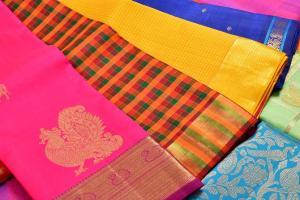The Indian Handloom industry is the second largest employment generator in the unorganised sector after Agriculture. Spreading across rural and semi-rural households there are a total of 23.77 lakh looms in India

Kanchipuram saris
India is a nation with a rich handloom heritage and it never fails to astonish us with the phenomenal varieties of designs and craft it has to offer. Indian weaving customs have existed for many centuries and have always portrayed the numerous interesting sub-societies inside our nation. With the motifs, designs, and techniques of weaving and crafting material varying with every couple of hundred square kilometres, handlooms have given a unique face and personality to the local
the population of every geographical region.
ADVERTISEMENT
Jawahar Singh, Co founder and CEO of Avishya.com says, "The Indian Handloom industry is the second largest employment generator in the unorganised sector after Agriculture. Spreading across rural and semi-rural households there are a total of 23.77 lakh looms in India. Of the total number of looms, 20.66 lakh are in rural areas and 3.11 lakh are in urban areas. Every state here has its own customs and traditions, so each one has a varying handloom heritage."
The Banarasi Sari called a 'bride's Sari' in the Northern regions of India, is one of the finest example of traditional bridal wear. It is embellished with gold/silver Jari and is woven with the top class silk in Varanasi. Equally grand and omnipresent across South Indian weddings and festive occasions are the Kanjivaram Sari from Kanchipuram in Tamilnadu. With a tradition which goes back hundreds of years, Kanchi silk Saris have a unique repertoire of motifs like Mayilchakkaram, Araimaadam, Annapakshi, Yazhi, Temple/Thandavalam borders etc. The 3 shuttle loom Kanchi Sari called the Korvai is an evergreen classic treasured by Sari connoisseurs. Also made using 3 shuttle looms is the Gadwal Sari from Gadwal district in Telengana. Gadwals are made in both Silk and Cotton and the silk Gadwal is the traditional wedding Sari for people from Andhra/Telangana.
Pochampalli Ikat Saris from Telangana are also much loved for their geometric prints in Ikat style. Kasavu is a traditional Kerala Sari which is an extension from the mundu Sari. Madhya Pradesh is the birthplace of the Chanderi and Maheshwari Saris and both varieties are woven with silk and Cotton. Usually silk forms the Weft and Cotton is the Warp of these Saris. Zari is tastefully and judiciously used to highlight butis of birds, flowers, cranes and geometrics in various Chanderi designs. Maheshwaris use pretty block prints in addition to woven geometric & colour block designs. From the western part of India Gujarat is the birthplace of
Bandhani. As the name suggests Bandhani Saris/kurtas/salwars dupattas are made by the art of tying and dyeing fabrics. Paithani the Sari traditionally worn by queens and royalty in Maharashtra is the most sought-after wedding Sari there. Woven with the finest silks or pure cottons they are distinctive in their style with peacock motifs and rich zari borders/pallus. Kota Doria Saris woven in Rajasthan are made of cotton and silk and consist of square-pattern weaves known as khats. These khats are distinctive indications of a Kota Doria Sari. Another famous weave from Rajasthan is Lehariya which is in trend for its colour burst designs and distinct streaming patterns. From the eastern region of India the Balucharis from Bishnupur, West Bengal are famous for their rich zari motifs which tell the stories of ancient Indian mythology and folklore. Each one of these handloom Saris types originating from different parts of India are unique and distinctly different from one another but offer stunningly beautiful looks which are unmistakable.
The Sambalpuri Sari comes from Odisha and is a distinctive Ikat Sari which is first tied and dyed and later braided into fabrics giving it a fine texture. Bomkai Saris from Odisha are famous for their unique tribal prints. Apart from Saris most Indian handloom weaving clusters also offer beautifully woven, printed or dyed Kurtas, Salwars, Dupattas and Stoles which complete the Indian woman’s wardrobe. Banarasis, Chikankari embroidery, Maheshwari Block Prints, Chanderi wovens, hand painted Kalamkaris, Lehariyas, intricate Jamdani / Kantha work from Bengal all offer options in other forms of traditional Indian apparel like Kurtas, Salwars and Anarkalis apart from lovely accessories like Stoles and dupattas.
The varieties are never-ending and are irresistible for aficionados of handcrafted weaves in India. Like the colourful festivals of India, we have colourful apparels across India – each with different creatives, motifs, and designs.
Catch up on all the latest Crime, National, International and Hatke news here. Also download the new mid-day Android and iOS apps to get latest updates
 Subscribe today by clicking the link and stay updated with the latest news!" Click here!
Subscribe today by clicking the link and stay updated with the latest news!" Click here!






